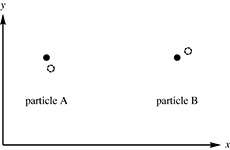Strange behavior of quantum particles may indicate the existence of other parallel universes

It started about five years ago with a practical chemistry question.
Little did Bill Poirier realize as he delved into the quantum mechanics of complex molecules that he would fall down the rabbit hole to discover evidence of other parallel worlds that might well be poking through into our own, showing up at the quantum level.
The Texas Tech University professor of chemistry and biochemistry said that quantum mechanics is a strange realm of reality. Particles at this atomic and subatomic level can appear to be in two places at once. Because the activity of these particles is so iffy, scientists can only describe what's happening mathematically by "drawing" the tiny landscape as a wave of probability.
Chemists like Poirier draw these landscapes to better understand chemical reactions. Despite the "uncertainty" of particle location, quantum wave mechanics allows scientists to make precise predictions. The rules for doing so are well established. At least, they were until Poirier's recent "eureka" moment when he found a completely new way to draw quantum landscapes. Instead of waves, his medium became parallel universes.
Though his theory, called "Many Interacting Worlds," sounds like science fiction, it holds up mathematically.
Originally published in 2010, it has led to a number of invited presentations, peer-reviewed journal articles and a recent invited commentary in the premier physics journal Physical Review.
"This has gotten a lot of attention in the foundational mechanics community as well as the popular press," Poirier said. "At a symposium in Vienna in 2013, standing five feet away from a famous Nobel Laureate in physics, I gave my presentation on this work fully expecting criticism. I was surprised when I received none. Also, I was happy to see that I didn't have anything obviously wrong with my mathematics."
In his theory, Poirier postulates that small particles from many worlds seep through to interact with our own, and their interaction accounts for the strange phenomena of quantum mechanics. Such phenomena include particles that seem to be in more than one place at a time, or to communicate with each other over great distances without explanations.
There is no fuzziness in his theory. Particles do occupy well-defined positions in any given world. However, these positions vary from world to world, explaining why they appear to be in several places at once. Likewise, quantum communication of faraway particles – something Albert Einstein called "spooky action at a distance" – is actually due to interaction of nearby worlds.
Waving goodbye?
Many Interacting Worlds theory doesn't prove that the quantum wave does not exist, or that many worlds do exist, Poirier said. The standard wave theory is perfectly fine in most respects, providing agreement with experiment, for example.
"Our theory, though based on different mathematics, makes exactly the same experimental predictions," he said.
"So what we have done is to open the possibility that the quantum wave may not exist. It now has only as much right to that claim as do many interacting worlds – no more and no less. This may be as definitive a statement as one can hope to make about a subject that has confounded the best minds of physics for a hundred years and still continues to generate controversy."
At this nanoscopic scale, particles don't act like larger objects, whose position over time is well defined, such as an airplane or an apple falling from a tree.

Instead, particles sometimes behave as fixed particles, and other times behave more like waves. Even weirder than this: when scientists look at a quantum particle, it behaves like a particle. When they're not looking, it suddenly starts acting like a wave.
Even Albert Einstein is said to have disagreed with the quantum idea that particles could exist in an approximate possible location or possibly more than one location at a time rather than just one place.
"I like to think the moon is there, even if I am not looking at it," Einstein famously said on the topic.
Scientists dissect and disagree to this day as to exactly what's happening on this tiny scale. Although they may not know for sure what's happening, they do at least know how to predict the wave-like behavior of the quantum particle when it's not being observed.
For this, they use the Schrödinger Equation, a mathematical description invented in the '20s that describes how these crazy particles move as a wave over time.
At least, they did until Poirier took another look at the wave and upended established quantum theory.
Some physicists can make much about the philosophy of quantum mechanics, Poirier said. For a chemist such as himself, however, he is less interested in the philosophy and more interested in solving Schrödinger's quantum wave equation to help him understand chemical reactions.
"In physical chemistry, we are interested in solving problems involving large, complex molecules as accurately as we can," he said. "We're looking for the reaction rate for a chemical reaction, the allowed quantum states of a molecule and the spectral 'fingerprint' that a molecule emits or absorbs when we shine a light on it. … There is a paradox here. To answer these kinds of questions accurately requires quantum mechanics, but solving quantum mechanics problems for large systems (more than three bodies) is extraordinarily difficult."
Chemists use traditional grid-based methods for solving the quantum wave equation. However, the more complex the molecule, the more complex the computations become. With each atom added to the molecule, about 10,000 times more additional computational effort is needed, he said.
To ease the computational burden, chemists borrowed an idea from engineers to allow the grid points to move like a liquid and "flow" with the quantum wave. Once moving, the grid points trace out trajectories, much like a baseball. While engineers use the technique to model fluid flow, chemists use it to help calculate the motion of the quantum wave –hence the term 'quantum hydrodynamics.'
At a certain point, Poirier wondered what would happen if you left the wave computations out and just worked with the quantum trajectories and if the simpler numerical simulation still would be valid.
"My key insight was to realize that all you really need are the moving quantum trajectories themselves," he said.
"The quantum wave is not actually needed to tell your trajectories how to move. The trajectories tell themselves how to move. Moreover, you don't need the wave for anything else either. Any scientific question that might be answered by knowing the motion of the wave can also be answered just as easily by knowing the motion of the trajectories alone. So the wave becomes completely extraneous and can be discarded altogether."
Window Into Wonderland
The concept of many quantum worlds isn't quite new. In the '50s, a graduate student at Princeton University named Hugh Everett III had a similar explanation to account for the strangeness of quantum mechanics.
Poirier said Everett Many Worlds theory is based on the standard quantum wave mathematics, so it is not clear where the worlds actually come from or how they're defined. Critics disagree with the theory for this reason and because the universes fork into countless more each time scientists, say, take a measurement.
In Poirier's Many Interacting Worlds approach, these worlds are built into the mathematics right from the start, so scientists don't have to do anything special to define them. It works, he said, because wave-based mathematics aren't used. Worlds never fork or merge the way Everett's worlds do, and Poirier's worlds interact with each other. Everett's do not.
"The Many Interacting Worlds theory works more like a flock of birds than an infinitely branching tree," he said.
Poirier compared figuring out quantum mechanics without the wave function to putting up scaffolding, building a structure inside and then realizing you just needed the scaffolding. From a practical point of view, fewer mathematical moving parts mean greater simplicity.
It also posed interesting questions about the physics philosophy on the wave and what it means if you don't need it, he said. Quantum trajectories may be more than just a computational tool. They actually may explain what is going on at the quantum level.
"People have argued for a long time about what the wave function means philosophically and how it should be interpreted," he said. "Now we suddenly realized that this may be entirely the wrong way to frame the argument. The more fundamental question should be, 'Does the wave function even exist, and if not, what takes its place?' At present, we cannot say definitively that the wave function does not exist. Only that its existence is not necessary, because we've found another mathematical method that provides all the same information. So, what does this new mathematics have to say about what takes the place of the wave function? What emerges from the math are parallel universes."
Poirier explained that in the classical physical world where humans operate, everything is in a definite state with respect to velocity and position. Think airplanes and apples falling out of trees. We can calculate where those things are and where they're going.
In quantum mechanics, scientists have to give that up. They can know where particles are or where they're going. Not both. The classical trajectory, with its well-defined particle attributes, has been replaced with the quantum probability wave that spreads out across many simultaneous possibilities.
However, by describing quantum realities using quantum trajectories alone, at least some of the old classical notions can be restored, Poirier said. According to this picture, quantum particles really do have well-defined attributes and follow definite quantum trajectories.
The catch is that one has to have many interacting worlds. In fact, quantum behavior itself may be regarded as evidence of definite particles from alternate universes poking through into our own, causing this blurry picture at the quantum scale.
"That's the most radical and interesting part of this approach," he said. "Assuming that reality is now described by many trajectories instead of a wave, we have to ask what these trajectories really mean, physically. The only sensible interpretation is to think of each trajectory as representing a different world. In each world, nothing is wave-like or indefinite. Everything is sharp and well-defined. But there are now multiple worlds. The variation across these worlds is where quantum uncertainty or 'fuzziness,' together with all other quantum behavior, actually comes from."
The apparent fuzziness of particle positions may be regarded as a manifestation of an inter-world interaction. Poirier says that while the wave equation still works, scientists can no longer say that it more naturally explains what's going on at the quantum scale than the idea of many alternate universes interacting together at the quantum scale.
Both are equally valid ways of interpreting reality that are consistent with current experiments.
As for describing what might be happening right now in other parallel universes, Poirier said that would be pure speculation.
"We don't have proof that an alternate me or you might be president," he said. "I can't say whether those worlds exist or not. According to the theory, the only worlds we can directly interact with are so close to our own world that we hardly can tell them apart, except at the quantum scale. So that might be a little bit boring for people who like to think in terms of science fiction. On the other hand, that doesn't rule out the possibility that there are indeed more distant worlds macroscopically different from our own where you and I are living out any number of counterfactual existences. We don't have any direct evidence for that. But then again, nor should we, according to the theory, even if such worlds do exist."
Provided by Texas Tech University





















